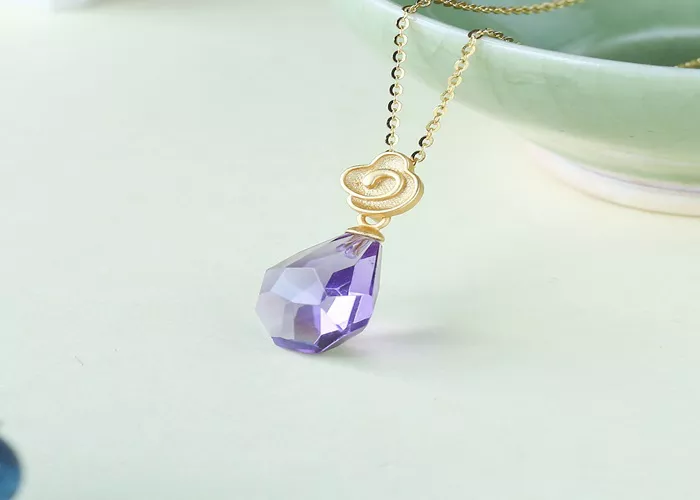Amethyst, a member of the quartz family, is a stunning gemstone known for its deep purple hue and mystical aura. Its name derived from the Greek word “amethystos,” meaning “not drunk,” reflects ancient beliefs in its ability to prevent intoxication. Today, amethyst jewelry is highly valued for its beauty and perceived spiritual qualities. However, as a jewelry appraiser, it’s crucial to understand that wearing amethyst involves several potential drawbacks that should be carefully considered. This article will explore these disadvantages in detail, providing a comprehensive guide for those considering adding amethyst to their jewelry collection.
1. Chemical Sensitivity and Stability Issues
Amethyst, like many gemstones, is susceptible to certain chemicals. This sensitivity can lead to color changes, dullness, or even damage over time.
Chemical Exposure Risks
Amethyst’s purple color is caused by trace amounts of iron and manganese in its crystalline structure. These elements can react with certain chemicals, causing the color to fade or alter. Common household chemicals such as bleach, perfume, and hairspray can all pose risks to amethyst jewelry. When these substances come into contact with the gemstone, they can penetrate its surface, leading to discoloration or even internal damage.
Stability in Various Environments
Amethyst’s stability can also be affected by environmental factors such as temperature and humidity. Extreme changes in these conditions can cause the gemstone to crack or break. For example, sudden exposure to heat or cold can lead to internal stress fractures within the crystal structure. Additionally, prolonged exposure to sunlight can fade the gemstone’s color over time.
2. Hardness and Durability Concerns
While amethyst is a relatively hard gemstone, with a Mohs hardness of 7, it’s not invincible. Its durability can be compromised in certain situations, making it prone to scratching, chipping, or breaking.
Scratching andAbrasion Risks
Amethyst’s hardness places it in the middle range of gemstones, meaning it’s harder than many minerals but softer than some others. This makes it susceptible to scratching when in contact with harder substances. For instance, wearing amethyst jewelry while engaging in activities like gardening or cleaning can result in scratches on the gemstone’s surface. These scratches can detract from its appearance and reduce its value.
Chipping and Breaking Hazards
In addition to scratching, amethyst can also chip or break if subjected to sudden impacts or pressure. This is particularly true for larger pieces of amethyst jewelry, such as pendants or rings, which are more exposed to potential hazards. Care should be taken to avoid hitting or dropping amethyst jewelry, as even minor impacts can cause damage.
3. Maintenance and Cleaning Challenges
Maintaining amethyst jewelry requires careful handling and specific cleaning techniques to preserve its beauty and prevent damage.
Gentle Cleaning Practices
Cleaning amethyst jewelry should be done with gentle, non-abrasive methods. Using harsh chemicals or scrubbing too vigorously can scratch the gemstone’s surface. Instead, it’s recommended to use a soft cloth dampened with warm water and a mild detergent to gently wipe away dirt and grime. After cleaning, the jewelry should be dried thoroughly with a soft cloth to prevent water spots.
Storage Considerations
Proper storage is also crucial for preserving amethyst jewelry. The gemstone should be stored in a soft cloth or jewelry pouch to prevent it from scratching other jewelry or being scratched itself. Additionally, amethyst should be kept away from direct sunlight and extreme temperatures to prevent color fading and internal stress fractures.
4. Potential Allergies and Skin Reactions
While amethyst itself is not known to cause allergic reactions, some individuals may experience skin irritation or sensitivity when wearing amethyst jewelry.
Allergic Reactions to Metals
The metal used to set amethyst can sometimes cause allergic reactions. Common metals like nickel, cobalt, and chromium are known allergens, and even gold and silver can cause sensitivity in some individuals. If you have a history of metal allergies, it’s important to choose jewelry that is hypoallergenic or made from metals that you are not sensitive to.
Skin Irritation from Dirt and Residue
Dirt, oils, and other residues can build up on amethyst jewelry over time, potentially causing skin irritation. Regular cleaning and maintenance can help reduce the risk of skin reactions by keeping the jewelry clean and free of impurities.
5. Ethical and Environmental Considerations
The mining and processing of gemstones, including amethyst, can have ethical and environmental impacts that should be considered by consumers.
Mining Practices
The mining of amethyst often involves the use of heavy machinery and chemicals, which can have negative effects on the environment. Some mining operations may also result in habitat destruction, water pollution, and soil erosion. Consumers should be aware of these issues and consider choosing jewelry from sources that prioritize ethical and sustainable mining practices.
Environmental Footprint
The environmental footprint of amethyst jewelry extends beyond mining to its production and distribution. The energy used in cutting, polishing, and transporting the gemstone can contribute to greenhouse gas emissions and other forms of environmental degradation. Choosing jewelry made from recycled or sustainably sourced materials can help reduce this environmental impact.
Conclusion
In conclusion, while amethyst jewelry is undoubtedly beautiful and mystical, it’s important to consider its potential drawbacks before making a purchase. From chemical sensitivity and stability issues to hardness and durability concerns, maintaining amethyst jewelry requires careful handling and specific cleaning techniques. Additionally, potential allergies, ethical and environmental impacts, and cost and value considerations should all be taken into account. By understanding these potential drawbacks, consumers can make informed decisions about whether amethyst jewelry is the right choice for their needs and lifestyle.
Related topic:
- How Does Amethyst Dream Stone Influence Your Dreams?
- 7 Creative Ways to Use Amethyst with Blue Agate in Decor
- Why Is Amethyst so Powerful


